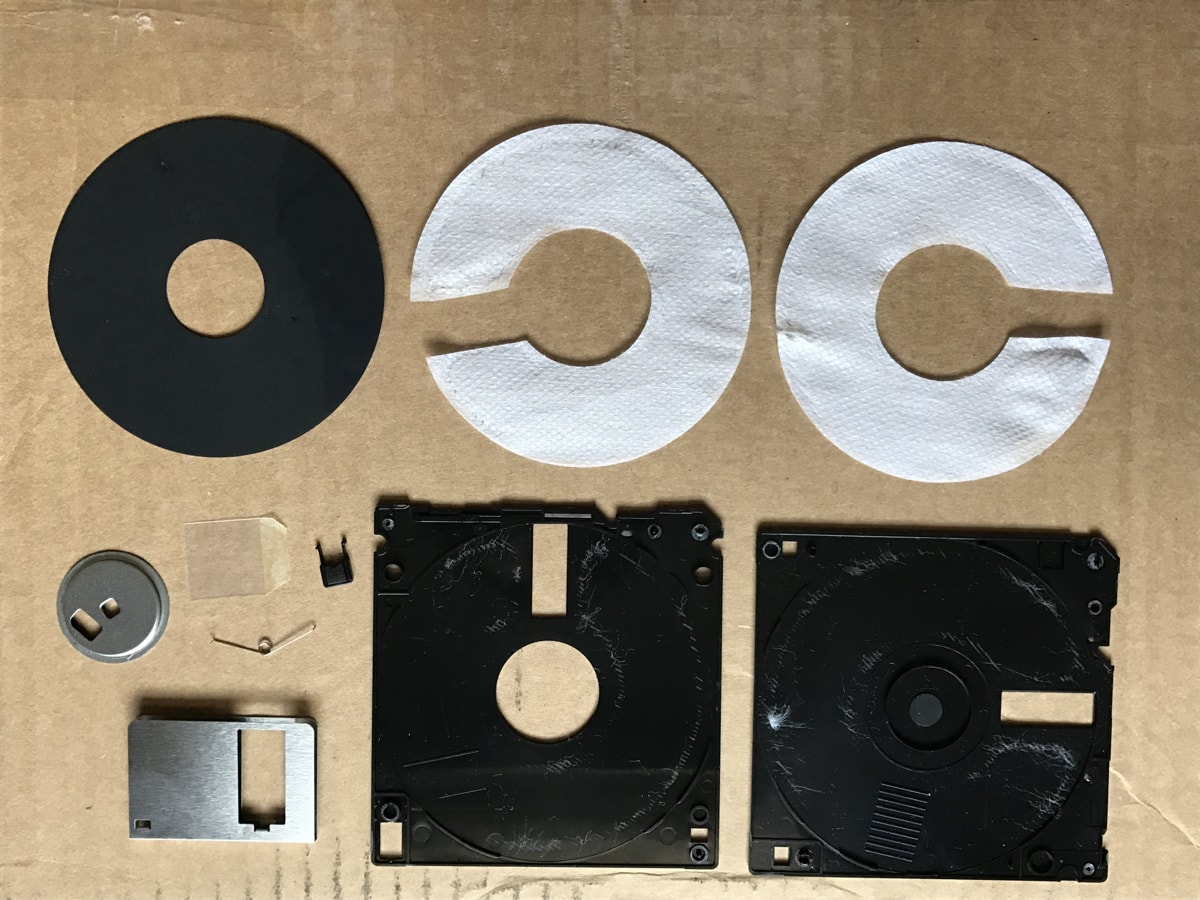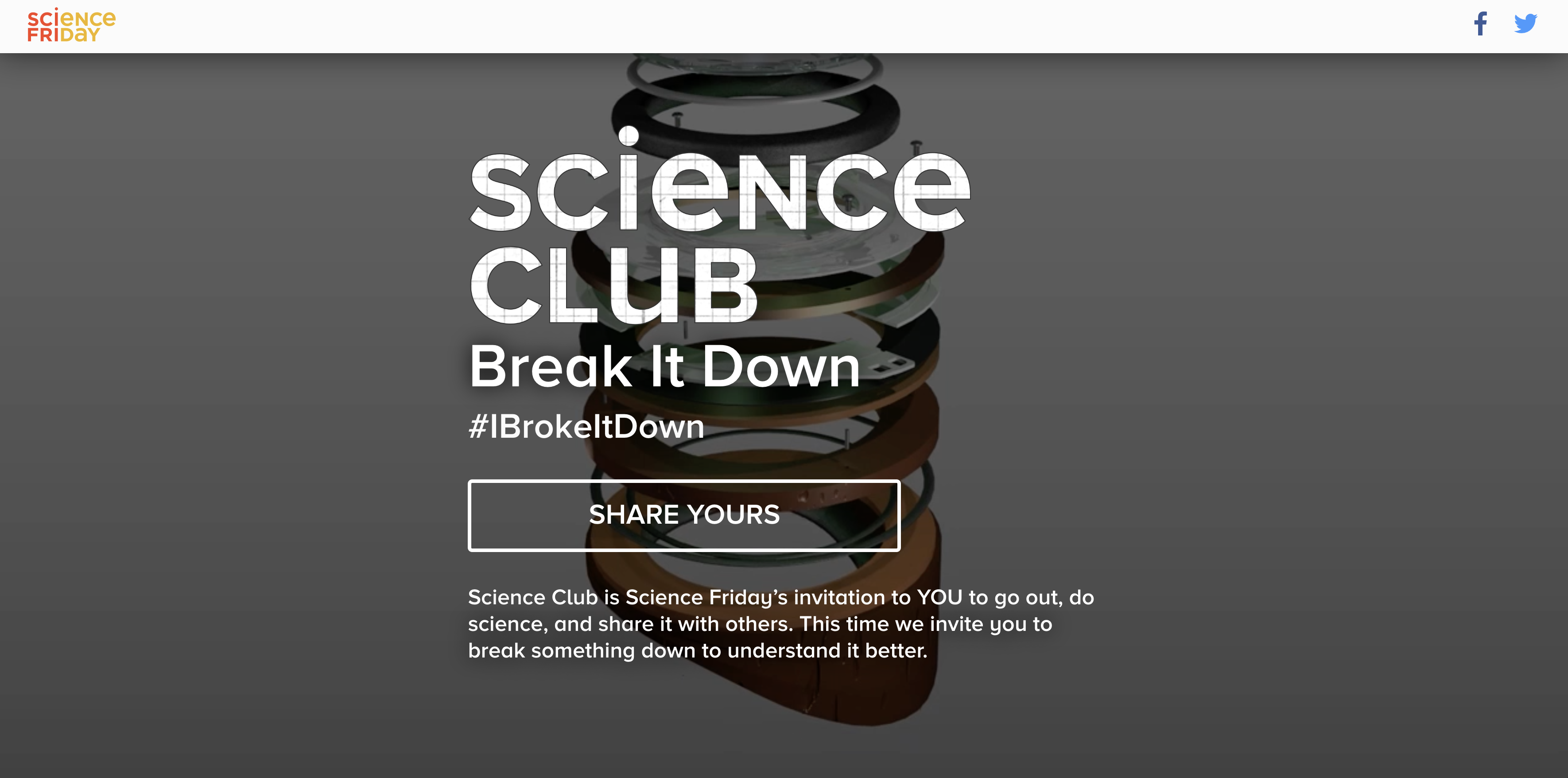The Science Club Challenges You to ‘Break It Down’
6:50 minutes
Science Friday’s Science Club is back in session! For this project, we’re challenging you to learn more about a complex thing by breaking it down or taking it apart. Whether you’re trying to understand the origins of language, the way a plant collects nutrients from the soil, what gives protons their mass, or how a speaker makes sound, examining component pieces usually reveals insight into how the whole thing works. In this live interview at the Sheldon Concert Hall in St. Louis, Science Friday’s Ariel Zych and Charles Bergquist explain how from now until December 9, you can explore your world—and share what you find at sciencefriday.com/scienceclub.



At our live show in St. Louis, MO we had our audience break down a floppy disk. You can check out more examples of people breaking it down (including your own!) at the science club site.
Breaking it down live in #stl with @scifri #ibrokeitdown @stlpublicradio #innovation #SciFri @explorestlouis pic.twitter.com/VRLo3rkytl
— Vin (@TheCoordinated) October 26, 2016
@scifri taught me to see old things in new ways. #IBrokeItDown pic.twitter.com/ixmCEOx1ZH
— Valerie (@ozarkVal) October 27, 2016
@scifri #ibrokeitdown pic.twitter.com/93mrJ8FBNO
— Mrs. Pelch (@npelch) October 26, 2016
Ariel Zych is Science Friday’s director of audience. She is a former teacher and scientist who spends her free time making food, watching arthropods, and being outside.
As Science Friday’s director and senior producer, Charles Bergquist channels the chaos of a live production studio into something sounding like a radio program. Favorite topics include planetary sciences, chemistry, materials, and shiny things with blinking lights.
IRA FLATOW: This is Science Friday. I’m Ira Flatow.
[GOOFY MUSIC PLAYING]
That sounds can only mean one thing. The Science Friday Science Club is back in session. Yes.
[APPLAUSE]
I’ve been talking about the theme for tonight. We’re calling it Breaking it Down, Break it Down. And by strange coincidence, that’s the theme of our latest Science Club project. And here to tell us about it are Science Friday’s education manager, Ariel Zych, and our director, Charles Bergquist, the founding members both of the Science Club. Big hand for them.
ARIEL ZYCH: Howdy.
[APPLAUSE]
IRA FLATOW: So tell us about the Science Club for people who don’t know what it is and what our project is.
ARIEL ZYCH: Sure, so Science Club is Science Friday’s attempt to get you to do something, and not just anything. We want you to do things that engineers do and scientists do. We want you to get a taste for it. And the best way to do that is to do yourself.
IRA FLATOW: Talk about why is breaking down– we talked about the soil before. Why is breaking down so important to science?
ARIEL ZYCH: Right, so things get broken down in the natural world all the time. We’ve already had a few biologists on today to talk about the carbon cycle breaking things down, breaking plant bits down so you can get at that genetic information. Right?
There’s a whole lot of other examples too. Breaking things down is a really important way to understand stuff that’s complex. Right? It’s the first thing you do if you want to reverse engineer something. If you want to break down a whole bunch of almost anything, you can ask a fungus to do it. Right? That’s a really important breaker downer.
CHARLES BERGQUIST: Sometimes you want to break something down too because you’ve got a big mixture of stuff and you can’t out what’s in it. This is a process called chromatography. You can try this at home with some filter paper. Even the stuff that’s in your coffee maker works just fine. And you can see that your orange marker is not pure orange. It’s got other colors in there. And you wouldn’t know that without being able to break it down into its component parts.
IRA FLATOW: I’m Ira Flatow. This is Science Friday from PRI, Public Radio International.
So now that you’ve got your glasses on that were provided by Google’s Making & Science Initiative. They’re not those Google glasses, but a different kind of Google glasses for you. We want to thank the Midwest Recycling Center for lending us– lending us? They’re not going to get a whole one back– giving us these different things to break down. Let’s get this thing going.
ARIEL ZYCH: All right, so open your envelopes if you’ve got one, or look upon your friend who’s got one. Pull out your 3D-printed Save icon or your keyboard and go to town. I’m not going to tell you how to do this. Just kidding. I’m going to tell you how to do this.
So I highly recommend taking your little metallic thing off. This is called a shutter. Oh, listen to that. I can hear everybody’s shutters getting popped off.
IRA FLATOW: The sounds of things breaking.
ARIEL ZYCH: Yeah, yeah, and if you’re lucky, you might catch the spring that flies out of there if you don’t have a spring. I hear people going to town. That’s good. Get in there. Don’t hold back.
IRA FLATOW: Yeah, see if you can–oh, he got the keyboard apart.
ARIEL ZYCH: Hey, we got some people with the keyboards. Nice.
IRA FLATOW: What does the inside of the keyboard look like?
ARIEL ZYCH: Yeah, we’ll find out.
IRA FLATOW: I have never seen such an excited audience before.
ARIEL ZYCH: I know. It’s like you’re all like looking inside of the floppy disk for the first time.
IRA FLATOW: You get permission to break something. It’s amazing. Charles is looking for some folks to talk to down here.
ARIEL ZYCH: Charles, what do you have over there?
CHARLES BERGQUIST: OK, so I am here with Aurelia. And she is opening up a keyboard.
ARIEL ZYCH: Hey.
CHARLES BERGQUIST: And she’s going to tell us what she’s finding in there.
AURELIA: I found the motherboard.
CHARLES BERGQUIST: The motherboard. I see a circuit board in there. What else do you see?
AURELIA: I see where the keyboard would be. There are just little dots everywhere.
ARIEL ZYCH: Little dots in there? Is that what I heard?
AURELIA: Mm-hmm.
ARIEL ZYCH: Cool. Did you find any big old rubbery mat thing?
AURELIA: Yes.
ARIEL ZYCH: Yeah, there’s one. Hold it up if you’ve got it. There’s a couple keyboards in the back too.
IRA FLATOW: Hold up your pieces. Let’s see what you got.
ARIEL ZYCH: Yeah, I want to see those floppy things that look like dead jellyfish. There you go.
IRA FLATOW: How can we share? How can everybody share what they’re seeing?
ARIEL ZYCH: Right, I’m sorry. So half the fun of learning is telling other people what you figured out is inside of a floppy disk, or what you figured out as you broke things down on your own. And as you go out and figure out what’s inside of other things that you explore this week, next week, the week after, we actually want you to tell us about it if you’ve got your phone with you right now and you’re a tweeter or an Instagramer, take a picture of whatever you found or what your neighbor found on the inside of this thing and tweet it with the hashtag #IBrokeItDown because you broke this thing down. You figured out something about it. Right? You can also Instagram it with this, if you’re into that. You can actually go to our website.
CHARLES BERGQUIST: Yeah, if you go to sciencefriday.com/scienceclub, you will find a nice form that will let you tell us all about what you’re breaking down and what you found inside. And it’s not just limited to what you’re doing here tonight. We’re just hoping that this is going to inspire you to go home and do something else, do something new. And over the course of the next month or so, tell us about whatever that other thing was.
Maybe you’re into linguistics. You can break down a text. Maybe you’re into music. You can send us sample cuts with different tracks broken down.
IRA FLATOW: And you can keep doing this. There’s no time limit on the project.
ARIEL ZYCH: No, in fact, if you break down a pumpkin this weekend, send it to us.
[LAUGHTER]
CHARLES BERGQUIST: Thanksgiving’s coming up. You can breakdown a turkey.
ARIEL ZYCH: Yeah, there’s a lot of things inside of a turkey.
CHARLES BERGQUIST: Save me a drumstick.
ARIEL ZYCH: Yes, exactly, save your drumstick. Do everything safely. So my teacher voice, I always talk like this. My teacher voice is to please be safe. So a well-ventilated area, protection as needed, nothing plugged in, kids. No electricity, please, no batteries. And make sure nothing’s alive
CHARLES BERGQUIST: Yeah. Kids, please ask your parents before taking apart the DVR.
ARIEL ZYCH: Yeah, be safe. Ask permission.
IRA FLATOW: Thank you. And this is something, we like to say, you can try at home.
ARIEL ZYCH: Please do.
IRA FLATOW: And we encourage you to do it. Thank you, Ariel. Thank you, Charles.
ARIEL ZYCH: Thank you.
IRA FLATOW: Ariel Zych, our education manager, our director, Charles Bergquist, founding members of the Science Club. And as I say, you can find out more and participate at sciencefriday.com/scienceclub. And we have a hashtag on social media, hashtag #IBrokeItDown. Thanks again.
Coming up, we’re going to shake things up a bit with a geologist who studies earthquakes. But first, Walsh and Buckley, come on out.
[MUSIC PLAYING]
I’m Ira Flatow. And this is Science Friday from PRI, Public Radio International.
Copyright © 2016 Science Friday Initiative. All rights reserved. Science Friday transcripts are produced on a tight deadline by 3Play Media. Fidelity to the original aired/published audio or video file might vary, and text might be updated or amended in the future. For the authoritative record of ScienceFriday’s programming, please visit the original aired/published recording. For terms of use and more information, visit our policies pages at http://www.sciencefriday.com/about/policies/
As Science Friday’s director and senior producer, Charles Bergquist channels the chaos of a live production studio into something sounding like a radio program. Favorite topics include planetary sciences, chemistry, materials, and shiny things with blinking lights.